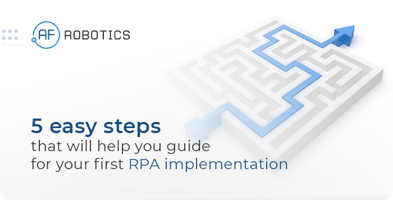1. What is and what is not RPA The RPA technology helps organizations to work in a more efficient...
5 competitive advantages of RPA for businesses
The benefits of RPA for businesses are many and varied. Developments in robotics and artificial intelligence in recent years have helped to significantly improve the accuracy of robots in the execution of various tasks. In this article, we present you 5 competitive advantages of this technology that will take your business one step ahead in the digital transformation race.
1). Reduction of human error
One of the most significant benefits of using RPA is the reduction of human error. With its automated capabilities, companies can achieve operational cost reductions of up to 50%.
In addition, employees are freed up to perform higher-value tasks. For example, software RPA can perform billing and contract generation processes with the same accuracy as human employees. And because it operates 24 hours a day, seven days a week, RPA can free up human resources to do more important tasks.
Despite this fact, there are still many areas of business where humans perform routine tasks. However, the use of RPA can improve the efficiency of repetitive tasks by reducing human error and increasing productivity. In addition, RPA has a low margin of error, which can lead to higher quality and competitiveness for companies.
2). Increased speed of execution
In terms of agility and speed, the benefits of RPA are evident in all organizations. This technology automates tasks that previously took hours or days to complete. As a result, companies can reduce human resources and focus on more valuable work. With increased automation, employees can focus on more productive tasks.
A successful RPA implementation results in a more efficient workforce. In addition to improving the bottom line of processes, successful RPA implementations also reduce stress and create a better working environment.
On the other hand, high-quality results are a hallmark of RPA robots. They are highly accurate, consistent and adhere to regulatory compliance. Moreover, as their workload increases, their quality does not diminish.
In contrast, human workers experience higher error rates as their workload increases. In addition, RPA bots operate without breaks, ensuring high accuracy and consistency. As a result, companies benefit from improved customer interaction and service.
Want to see a demo? Click here and learn about the power of RPA.
3). Simplification of tasks
With the rise of artificial intelligence, robotic process automation (RPA) software has become a key player in the business world. RPA is a versatile technology that uses machine learning, artificial intelligence and Internet of Things (IoT) technology to mimic human actions.
For example, financial reports are routine tasks for a company, and department heads spend two weeks on each report. RPA can reduce the time it takes to produce them while improving accuracy, allowing the CFO to make more accurate decisions. And because financial reports involve multiple communications and repetitive tasks, RPA can also be beneficial in other departments.
4). Eliminating bottlenecks
Eliminating bottlenecks in RPA for businesses starts with identifying problem points in workflows. This can be achieved by using business process management software: a customized table of performance indicators is a useful tool for identifying gaps that slow down processes.
Another type of deadlock is the long-term type. This occurs frequently and can lead to wasted resources, unhappy customers, poor quality products and higher costs. In addition, it can lead to employee stress. With RPA, these bottlenecks are eliminated through process diagramming and modeling, tasks based on prior diagnosis and detailed assessment of failures and delays.
5). Application Integration
APIs have numerous uses and are the preferred route in long-term strategic business use cases. However, while RPA provides a better out-of-the-box solution, API integration can provide better data flow into other business processes.
RPA has the advantage of being a lightweight technology, which can be adopted without changing any existing IT systems. This is an advantage, as many organizations have legacy systems and find it difficult to optimize their processes. In addition, reinventing the wheel with legacy IT systems can be a costly endeavor.
An example of the flexibility of RPA is in the retail industry, which has seen an increase in its use, thanks to the rise of e-commerce. Popular applications include customer relationship management (CRM), warehouse management, fraud detection and customer feedback processing.





